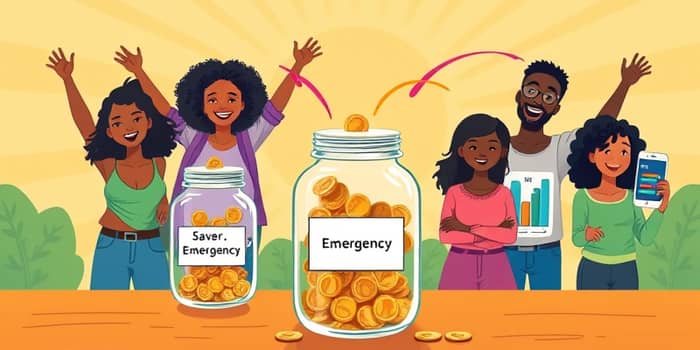In the journey toward financial resilience and peace of mind, building an emergency fund stands as a crucial milestone. Imagine waking up one morning to an unexpected medical bill or a sudden car repair, and instead of panic, feeling confident in your ability to cover the cost. This cushion between you and financial stress empowers you to handle life’s curveballs with grace and stability.
Yet for many, the road to saving can feel overwhelming. Between rent, groceries, and daily expenses, finding a way to consistently set aside cash may seem impossible. Thankfully, the digital age has brought powerful tools that can turn saving from a chore into an intuitive habit. By leveraging the right app, you can establish fully insured and easily accessible savings—all without manual transfers or tedious tracking.
Why build an emergency fund?
An emergency fund is a stash of money reserved for life’s unpredictable surprises, from job loss to urgent home repairs. According to a 2024 Bankrate survey, only 44% of Americans could cover a $1,000 emergency with savings, and 63% admit rising inflation has forced them to cut back on saving. Without these reserves, families may rely on high-interest debt or credit cards, compounding stress and financial strain.
- Protects against unexpected financial surprises like job loss
- Avoids costly high-interest debt during emergencies
- Provides peace of mind to weather any storm
- Supports long-term financial stability and confidence
Establishing a reserve equal to three to six months of essential expenses is a sound guideline. Storing these funds in a safe, liquid account—such as a savings or money market account with FDIC or SIPC coverage—ensures both security and accessibility when you need it most.
Criteria for evaluating emergency fund apps
With dozens of budgeting and savings apps available, selecting the right one demands clear criteria. Not every app aligns with each person’s habits, goals, or financial situation. To make an informed choice, consider the following:
- Automation capabilities for regular saving without manual intervention
- Smart goal setting and progress tracking
- Secure connectivity with your bank accounts
- Clear fee structure and cost transparency
- Top-notch security and deposit protection
- Educational resources to build money skills
A strong app streamlines the saving process, offers visibility into progress, and provides safeguards so you can focus on growth rather than worry over technical details.
Top recommended apps
No single app fits every saver perfectly. Below are seven of the best tools for building an emergency fund, each with unique strengths and fee structures.
You Need A Budget (YNAB) follows a zero-based budgeting philosophy, assigning every dollar a job—whether spending, saving, or investing. With powerful goal tracking tools and real-time bank syncing, YNAB encourages proactive planning and offers robust reporting. Educational workshops and a supportive community add extra motivation. The trade-off is its $14.99 monthly fee, making it best for disciplined budgeters seeking structure.
Qapital excels at simplicity. After a 30-day trial, plans start at $3 per month. Users create savings rules—round-ups, recurring deposits, or custom triggers based on spending habits—and watch their fund grow with out-of-sight out-of-mind automated savings. It’s ideal for couples and individuals preferring a set-and-forget approach.
Acorns blends micro-investing with emergency saving by rounding up purchases and investing the spare change. Starting at $3 per month, Acorns offers educational content for beginner investors. While it leans toward long-term growth, its “Later” retirement and “Spend” checking features can complement the safety of dedicated emergency reserves.
Oportun, formerly Digit, analyzes income and spending patterns to move small amounts into savings automatically. After a 30-day free period, the $5 monthly fee unlocks custom goals and FDIC-backed deposit protection. It’s perfect for savers who want effortless automation and minimal manual input.
Goodbudget revives the classic envelope budgeting system in digital form. Users allocate funds to virtual envelopes—rent, groceries, and savings—and track spending by “emptying” envelopes. There’s a free tier with limited envelopes and a premium $10 monthly plan for unlimited use. This solution provides a hands-on envelope budgeting experience for partners or families sharing finances.
PocketGuard offers a simple interface that shows “In My Pocket” spending limits after accounting for bills, goals, and savings. Basic features are free, while premium adds custom categories and automatic savings. Its biggest draw is clarity in spending versus saving potential.
Rocket Money stands out by combining subscription tracking, bill negotiation, and savings automation under “Auto-Pilot.” Users gain insights to cancel unwanted services, negotiate lower bills, and divert the savings toward a dedicated emergency stash. Pricing varies, but many features are free to start.
Other notable mentions include Chime, Empower, Quicken Simplifi, and Monarch—each delivering unique budgeting insights, early direct deposit perks, and coaching tools to suit varied preferences and goals.
Comparison of top apps
To help visualize how these tools compare, consider this overview:
Savings strategies to maximize your emergency fund
Building a fund quickly requires consistency, foresight, and the right tactics. Apps can shoulder much of the workload, but your strategy brings it across the finish line.
- Automate small daily or weekly transfers
- Set clear, realistic milestones
- Leverage budget apps to free up extra cash
- Use easy access and deposit insurance protection accounts
By starting with modest contributions and gradually increasing them, you create a sustainable habit that won’t strain your monthly budget. Tracking progress visually creates a positive feedback loop, motivating you to stay on course.
Tips for selecting the right app
Choosing a savings app goes beyond features and fees. Reflect on your natural financial habits: do you need hands-on control, or do you prefer discreet automation? Consider security certifications, user reviews, and the availability of customer support. Compare the app fees against the time savings and potential yield improvements you’ll gain. If you’re new to budgeting, an app with robust educational content can be a game-changer. Meanwhile, experienced savers may value advanced reporting and customization.
Conclusion
Establishing an emergency fund is a foundational step toward lasting financial well-being. The right app transforms this vital goal into a seamless part of daily life, helping you avoid debt and maintain peace of mind. Whether you choose the structure of YNAB, the hands-off automation of Qapital and Oportun, or the envelope approach of Goodbudget, each solution offers a path to a stronger financial future.
Take action today: set a realistic starting goal, pick an app aligned with your style, and embrace the confidence that comes from being prepared. Your future self will thank you for building the safety net you deserve.
References
- https://www.nerdwallet.com/article/finance/best-budget-apps
- https://www.nasdaq.com/articles/6-apps-building-your-emergency-fund-2025
- https://www.depositaccounts.com/blog/best-money-saving-apps.html
- https://www.lithiosapps.com/blog/top-10-apps-in-2025-for-building-financial-freedom
- https://www.techrepublic.com/article/best-money-saving-apps/
- https://investor.vanguard.com/investor-resources-education/emergency-fund/why-you-need-one
- https://www.investopedia.com/how-to-start-an-emergency-fund-11729333
- https://www.morganstanley.com/articles/how-to-build-an-emergency-fund










